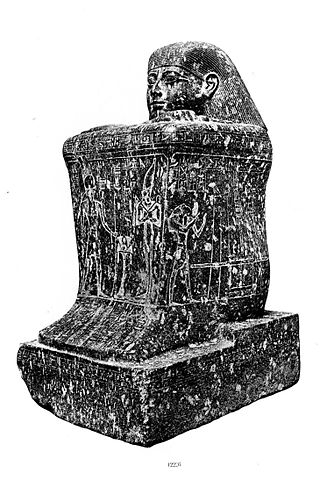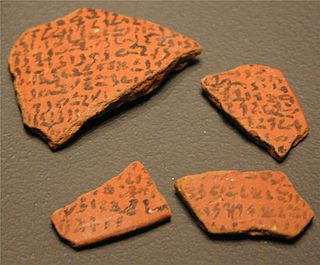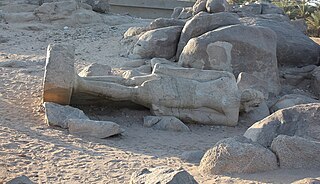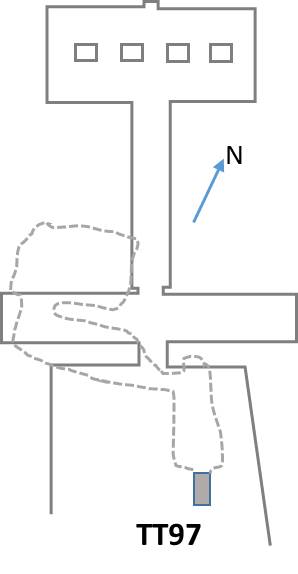
Tanis or San al-Hagar is the Greek name for ancient Egyptian ḏꜥn.t, an important archaeological site in the northeastern Nile Delta of Egypt, and the location of a city of the same name. It is located on the Tanitic branch of the Nile, which has long since silted up.

The Valley of the Queens is a site in Egypt, in which queens, princes, princesses, and other high-ranking officials were buried. Pharaohs themselves were buried in the Valley of the Kings. The Valley of the Queens was known anciently as Ta-Set-Neferu, which has a double meaning of "The Place of Beauty" and/or "the Place of the Royal Children". Excavation of the tombs at the Valley of the Queens was pioneered by Ernesto Schiaparelli and Francesco Ballerini in the early 1900s.

The ushabti was a funerary figurine used in ancient Egyptian funerary practices. The Egyptological term is derived from 𓅱𓈙𓃀𓏏𓏭𓀾 wšbtj, which replaced earlier 𓆷𓍯𓃀𓏏𓏭𓀾 šwbtj, perhaps the nisba of 𓈙𓍯𓃀𓆭 šwꜣb "Persea tree".

Sehertawy Intef I was a local nomarch at Thebes during the early First Intermediate Period and the first member of the 11th Dynasty to lay claim to a Horus name. Intef reigned from 4 to 16 years c. 2120 BC or c. 2070 BC during which time he probably waged war with his northern neighbor, the Coptite nomarch Tjauti. Intef was buried in a saff tomb at El-Tarif, known today as Saff el-Dawaba.

Tomb KV7 was the tomb of Ramesses II, an ancient Egyptian pharaoh during the Nineteenth Dynasty.

Shoshenq VI is known to be Pedubast I's immediate successor at Thebes based upon the career of the Letter Writer to Pharaoh Hor IX, who served under Osorkon II and Pedubast I. Since Shoshenq VI's prenomen is inscribed on Hor IX's funerary cones, this indicates that Hor IX outlived Pedubast I and made his funeral arrangements under Shoshenq VI instead. His prenomen or royal name was "Usermaatre Meryamun Shoshenq" which is unusual because it is the only known example where the epithet "Meryamun" appears within a king's cartouche. Shoshenq VI's High Priest of Amun was a certain Takelot who first appears in office in Year 23 of Pedubast I.

The Valley of the Kings, also known as the Valley of the Gates of the Kings, is an area in Egypt where, for a period of nearly 500 years from the Eighteenth Dynasty to the Twentieth Dynasty, rock-cut tombs were excavated for pharaohs and powerful nobles under the New Kingdom of ancient Egypt.

Execration texts, also referred to as proscription lists, are ancient Egyptian hieratic texts, listing enemies of the pharaoh, most often enemies of the Egyptian state or troublesome foreign neighbors. The texts were most often written upon statuettes of bound foreigners, bowls, or blocks of clay or stone, which were subsequently destroyed. The ceremonial process of breaking the names and burying them was intended to be a sort of sympathetic magic that would affect the persons or entities named in the texts. The fragments were usually placed near tombs or ritual sites. This practice was most common during times of conflict with the Asiatic neighbors of Egypt.
Donald P. Ryan is an American archaeologist, Egyptologist, writer and a member of the Division of Humanities at Pacific Lutheran University in Tacoma, Washington. His areas of research interest include Egyptian archaeology, Polynesian archaeology, the history of archaeology, the history of exploration, ancient languages and scripts, and experimental archaeology. He is best known for his research in Egypt including excavations in the Valley of the Kings where he investigated the long-neglected undecorated tombs in the royal cemetery. His work there resulted in the rediscovery of the lost and controversial tomb KV60, the re-opening of the long-buried KV21 with its two female and likely royal occupants, and the re-excavation of tombs KV27, KV28, KV44, KV45, KV48, KV49 along with work in KV20. In 2017, he rediscovered three small tombs in the Valley of the Kings which when first encountered in 1906 contained the mummies of animals including a dog and monkeys.
This is a glossary of ancient Egypt artifacts.

TT1 is the burial place of the ancient Egyptian official Sennedjem and members of his family in Deir el-Medina, on the west bank of the Nile opposite Luxor. The funerary complex consists of three pyramid-shaped chapels dedicated to, from south to north, Sennedjem's father or brother, Sennedjem himself, and Sennedjem's son Khonsu. Of the three shafts associated with the chapels, only the shaft in front of Sennedjem's chapel was unrobbed. It leads to a series of underground rooms, including the extensively decorated burial chamber.

Ahmose was a princess of the Seventeenth Dynasty of Egypt. She was the only known daughter of Seqenenre Tao by his sister-wife Sitdjehuti. She was the half-sister of Pharaoh Ahmose I and Queen Ahmose-Nefertari. Her titles are King's Daughter; King's Sister.

The Theban Tomb TT137 is located in Sheikh Abd el-Qurna. It forms part of the Theban Necropolis, situated on the west bank of the Nile opposite Luxor.

Sekhemre Sementawy Djehuty was a minor king reigning over parts of Upper Egypt during the Second Intermediate Period.

Tombos or Tumbus is an archaeological site in northern Sudan, including Tombos island and the nearby riverbank area. Tombos is located at the Third Cataract of the Nile and on the northern margin of the Dongola Reach, not far from Kerma. The occupation of Tombos, revealed by archaeological work, began in mid-18th Dynasty of Egypt and continued through the 25th Dynasty. In the New Kingdom period, a large range of pharaonic and private royal inscriptions from 18th Dynasty and elite tombs in Egyptian style indicates Tombos was an important node of Egyptian colonial control. In the New Kingdom, Tombos witnessed the blending and entanglement of Egyptian and Nubian traditions.
Kampp 150 is an ancient Egyptian tomb located in the Dra' Abu el-Naga' necropolis in Thebes. Based on a cartouche inscription, it probably dates back to the reign of Thutmose I of the Eighteenth Dynasty.
Senimen was an ancient Egyptian official who lived at the beginning of the 18th Dynasty and who was tutor of the king's daughter Neferure. The latter had an exceptionally high status under the ruling queen Hatshepsut.

The Theban Tomb TT97 is located in Sheikh Abd el-Qurna, part of the Theban Necropolis, on the west bank of the Nile, opposite to Luxor. The tomb belongs to an ancient Egyptian named Amenemhat, who was the High Priest of Amun at Karnak, during the reign of pharaoh Amenhotep II of the 18th Dynasty. Amenemhat was the son of the wab-priest and "Overseer of the sandal makers of Amun", Djehutyhotep.

Tomb A.6 is the modern number given to a now lost Theban tomb in Dra' Abu el-Naga'. The burial dates to the ancient Egyptian 18th Dynasty and belonged to the overseer of the marshland dwellers Dhjehutinefer, who is also called Seshu. The place was visited by the expedition of Karl Richard Lepsius, who copied the tomb owner's title overseer of the marshland dwellers of the lord of the two lands, but not the name. It seems that the tomb was then already heavily destroyed. Before 1906 the French Egyptologist Henri Gauthier visited A.6 and described the few remains of the decoration and published a short note. Gauthier recorded some further titles of Dhjehutinefer, such as scribe and counter of cattle and fowl of the temple of Amun. A fragment belonging to the tomb is a wall painting that is today in the Metropolitan Museum in New York. On the fragment in New York also mentioned the wife of Djehutinefer, a woman called Benbu. Several funerary cones belonging to the tomb are known. They provide the name of Djehutynefer's father who was the scribe Mesu.















